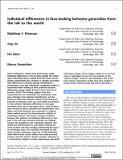Individual differences in face-looking behavior generalize from the lab to the world
Author(s)
Peterson, Matthew F; Lin, Jing; Zaun, Ian E.; Kanwisher, Nancy
DownloadKanwisher_Individual differences.pdf (62.62Mb)
PUBLISHER_CC
Publisher with Creative Commons License
Creative Commons Attribution
Terms of use
Metadata
Show full item recordAbstract
Recent laboratory studies have found large, stable individual differences in the location people first fixate when identifying faces, ranging from the brows to the mouth. Importantly, this variation is strongly associated with differences in fixation-specific identification performance such that individuals' recognition ability is maximized when looking at their preferred location (Mehoudar, Arizpe, Baker, & Yovel, 2014; Peterson & Eckstein, 2013). This finding suggests that face representations are retinotopic and individuals enact gaze strategies that optimize identification, yet the extent to which this behavior reflects real-world gaze behavior is unknown. Here, we used mobile eye trackers to test whether individual differences in face gaze generalize from lab to real-world vision. In-lab fixations were measured with a speeded face identification task, while real-world behavior was measured as subjects freely walked around the Massachusetts Institute of Technology campus. We found a strong correlation between the patterns of individual differences in face gaze in the lab and real-world settings. Our findings support the hypothesis that individuals optimize realworld face identification by consistently fixating the same location and thus strongly constraining the space of retinotopic input. The methods developed for this study entailed collecting a large set of high-definition, wide field-of-view natural videos from head-mounted cameras and the viewer's fixation position, allowing us to characterize subjects' actually experienced real-world retinotopic images. These images enable us to ask how vision is optimized not just for the statistics of the ''natural images'' found in web databases, but of the truly natural, retinotopic images that have landed on actual human retinae during real-world experience.
Date issued
2016-05Department
Massachusetts Institute of Technology. Department of Brain and Cognitive SciencesJournal
Journal of Vision
Publisher
Association for Research in Vision and Ophthalmology (ARVO)
Citation
Peterson, Matthew F. et al. “Individual Differences in Face-Looking Behavior Generalize from the Lab to the World.” Journal of Vision 16, 7 (May 2016): 12, 1-18
Version: Final published version
ISSN
1534-7362